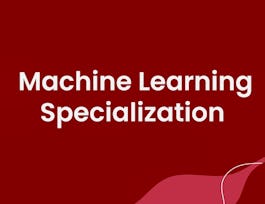Probabilistic graphical models (PGMs) are a rich framework for encoding probability distributions over complex domains: joint (multivariate) distributions over large numbers of random variables that interact with each other. These representations sit at the intersection of statistics and computer science, relying on concepts from probability theory, graph algorithms, machine learning, and more. They are the basis for the state-of-the-art methods in a wide variety of applications, such as medical diagnosis, image understanding, speech recognition, natural language processing, and many, many more. They are also a foundational tool in formulating many machine learning problems.



Probabilistic Graphical Models 3: Learning
This course is part of Probabilistic Graphical Models Specialization

Instructor: Daphne Koller
Sponsored by IEM UEM Group
21,930 already enrolled
(301 reviews)
Skills you'll gain
Details to know

Add to your LinkedIn profile
8 assignments
See how employees at top companies are mastering in-demand skills

Build your subject-matter expertise
- Learn new concepts from industry experts
- Gain a foundational understanding of a subject or tool
- Develop job-relevant skills with hands-on projects
- Earn a shareable career certificate


Earn a career certificate
Add this credential to your LinkedIn profile, resume, or CV
Share it on social media and in your performance review

There are 8 modules in this course
This module presents some of the learning tasks for probabilistic graphical models that we will tackle in this course.
What's included
1 video
This module contains some basic concepts from the general framework of machine learning, taken from Professor Andrew Ng's Stanford class offered on Coursera. Many of these concepts are highly relevant to the problems we'll tackle in this course.
What's included
6 videos
This module discusses the simples and most basic of the learning problems in probabilistic graphical models: that of parameter estimation in a Bayesian network. We discuss maximum likelihood estimation, and the issues with it. We then discuss Bayesian estimation and how it can ameliorate these problems.
What's included
5 videos2 assignments
In this module, we discuss the parameter estimation problem for Markov networks - undirected graphical models. This task is considerably more complex, both conceptually and computationally, than parameter estimation for Bayesian networks, due to the issues presented by the global partition function.
What's included
3 videos1 assignment1 programming assignment
This module discusses the problem of learning the structure of Bayesian networks. We first discuss how this problem can be formulated as an optimization problem over a space of graph structures, and what are good ways to score different structures so as to trade off fit to data and model complexity. We then talk about how the optimization problem can be solved: exactly in a few cases, approximately in most others.
What's included
7 videos2 assignments1 programming assignment
In this module, we discuss the problem of learning models in cases where some of the variables in some of the data cases are not fully observed. We discuss why this situation is considerably more complex than the fully observable case. We then present the Expectation Maximization (EM) algorithm, which is used in a wide variety of problems.
What's included
5 videos2 assignments1 programming assignment
This module summarizes some of the issues that arise when learning probabilistic graphical models from data. It also contains the course final.
What's included
1 video1 assignment
This module contains an overview of PGM methods as a whole, discussing some of the real-world tradeoffs when using this framework in practice. It refers to topics from all three of the PGM courses.
What's included
1 video
Instructor

Offered by
Why people choose Coursera for their career




Learner reviews
301 reviews
- 5 stars
71.09%
- 4 stars
19.26%
- 3 stars
5.64%
- 2 stars
2.99%
- 1 star
0.99%
Showing 3 of 301
Reviewed on Jan 28, 2018
Great course! It is pretty difficult - be prepared to study. Leave plenty of time before the final exam.
Reviewed on Jun 23, 2017
Had a wonderful Experience, Thank you Daphne Ma'am
Reviewed on May 30, 2020
1) The fórums need better assistance.
Recommended if you're interested in Data Science

University of Alberta

Illinois Tech

University of Washington

Stanford University

Open new doors with Coursera Plus
Unlimited access to 10,000+ world-class courses, hands-on projects, and job-ready certificate programs - all included in your subscription
Advance your career with an online degree
Earn a degree from world-class universities - 100% online
Join over 3,400 global companies that choose Coursera for Business
Upskill your employees to excel in the digital economy


